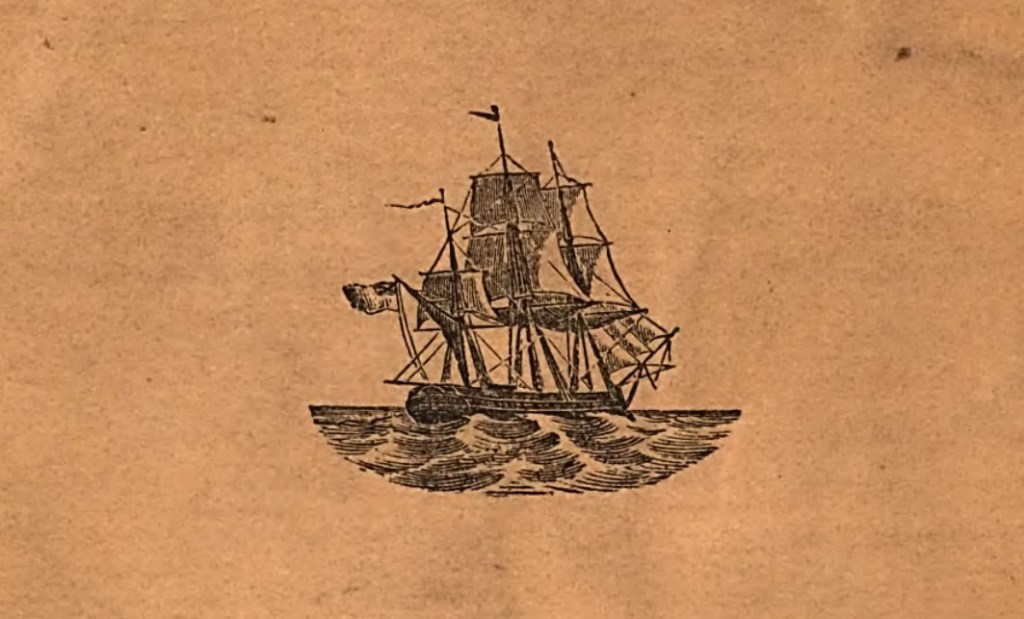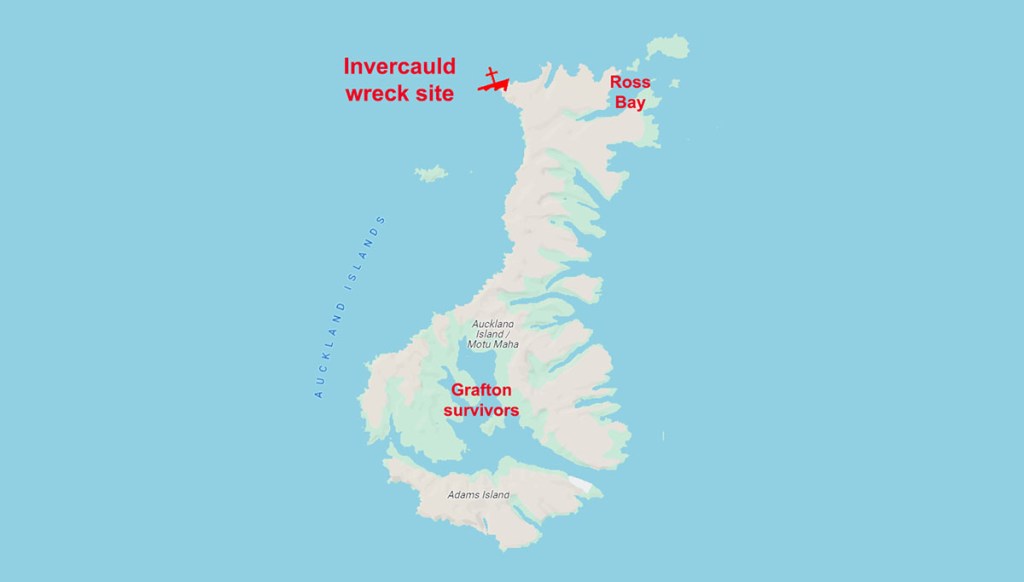
In recent years the loss of the Invercauld and its tragic aftermath have been held up as an example of what can go horribly wrong when leadership fails. In contrast to the Grafton, where all five men stranded on Auckland Island survived, only three of the Invercauld’s 25-man crew lived through the ordeal. The huge loss of life is frequently attributed to a failure of leadership. However, that narrative is based on a memoir penned 60 years after the event, which did not see the light of day until the late 1990s. It was reportedly written by Robert Holding, one of the three survivors and stands in stark contrast to the contemporary accounts left by the other two. This is their story, and it is no less fascinating.
The Invercauld was an 888-ton merchant ship under the command of Captain George Dalgarno. She sailed from Melbourne on 3 May 1864, bound for the Peruvian port of Callao in ballast. They were to take on a cargo of guano there before returning to England.
Shortly after clearing Port Phillip Bay, the weather turned foul. As they sailed southeast, they battled strong winds, high seas, rain, sleet and snow. Then, on 10 May, the lookout sighted land ahead, which Dalgarno took to be the Auckland Islands. Thinking they had sighted the southern end of the Aucklands, Dalgarno brought the ship a little more to the south, expecting to pass them to the south. All the time, it was blowing hard from the northward, and they were ploughing through high seas, and visibility was much reduced by rain showers.
To Dalgarno’s great surprise and alarm, the lookout called land ahead again. The captain had the ship brought around to the north and heaped on as much sail as circumstances would allow, hoping to pass through what he thought was a channel separating two separate Islands. By now, it was fully dark, and the weather continued to rage around them. They were now in a perilous situation where they were being blown towards a lee shore.

High cliffs loomed out of the inky darkness on the starboard side, and then they were caught in breaking surf and lost all control of the ship. She ran aground broadside to the rocky shore, and waves crashed over the deck. There was no time to think about getting a lifeboat over the side, for the Invercauld almost immediately started breaking up. The men ditched their boots and heavy outer layer of clothing as the ship came apart under their feet. Twenty-five men were swept into the turbulent sea during those terrifying minutes to be washed ashore in a small cove between two towering cliffs. Only 19 survived the sinking, and all were battered and bruised from being tossed against rocks and timber debris.
The sodden survivors huddled together for warmth on the beach during that freezing first night as the sea spray, rain, and snow beat upon them. In the early hours, they built a lean-to from wreckage washed onto the rocks to provide themselves some shelter from the elements. The next morning, all that could be salvaged by way of food was one kilogram of sea biscuit and a similar amount of salted pork. Not much to sustain 19 cold and hungry men. The steward had also saved a box of matches which would prove lifesaving once they had dried out.
That day, they climbed out of the cove to the heights above. Unfortunately, they lost another shipmate when he slipped and fell. Once clear of the cliffs, they headed east, pushing their way barefoot through dense grassland and scrub. They were trying to reach the more sheltered eastern side of the island. Fortunately, they did not want for water. They caught a small pig which was cooked and shared out equally giving everyone some brief respite from their diet of edible roots.
Four men died from fatigue and exposure during the trek across the island. Six men, including Holding, broke away from the main party. Not wishing to bash through the dense bush any longer, they returned to the wreck site. Holding rejoined the rest of the crew a few days later but the other five were never seen again. After a couple of weeks of toiling through the densely vegetated interior, the remaining ten castaways descended into a bay on the eastern side of the island. There, they found an abundance of limpets fixed to the rocky shore and feasted as only starving men could.
They remained camped there until they had cleaned it out of shellfish. Then, they decided to make for the next bay and on reaching a ridge they could see two huts in the distance. Believing they had found a small settlement, they descended into Ross Bay to discover the huts had long been abandoned. But, they offered shelter from the elements and the hope that sealers or someone else might return during the summer months. The huts were likely the remains of Enderby’s short-lived whaling station, which had been abandoned over a decade earlier.

For a time, their fortunes were much improved. The huts proved a treasure trove of rubbish that could be repurposed. Empty tin cans were used to boil limpets, a sheet of iron served as a hotplate over their cooking fire, and the discovery of an old adze and hatchet made cutting firewood so much easier. On their first day, a couple of the men caught and killed a seal, which they feasted on. Unfortunately, they found few others, and largely survived on a diet of limpets and wild roots.
Andrew Smith, the chief mate and narrator of the only contemporary detailed account of the wreck and its aftermath, Robert Holding and two others set off to find a better place to establish a camp where food might be more abundant. By the time they found a suitable cove and returned to collect the others, only the captain was still alive. The rest had succumbed to the cold and starvation.
After four or five months on the island, only Dalgarno, Smith and Holding were still alive. They constructed a canoe using sealskin stretched over a sapling frame. Though it could carry only two men and leaked so badly that one was required to bail continuously while the other paddled, it allowed them to search for food more easily than traversing the rocky foreshore on foot. Surviving on a diet of fish, sea birds and the occasional seal they made it through to summer, but that brought a different set of miseries. Sandflies savaged them, and any seal meat or fish left for more than a day or so became fly-blown.
With rescue seeming unlikely, they returned to the huts and demolished them. They built a raft from the timbers and returned to their camp to construct a boat so they could escape the island. However, shortly after it finished, a storm lashed the island and swept the boat out to sea. They built a second boat from the remaining timbers and used it over the next several months to travel around Ross Bay and across to nearby islands in search of seals and other food. On one occasion, they ventured across to an island to their east, where they found rabbits in abundance. At first, they proved too elusive to catch, but in time, the small animals became an important source of skins and sustenance.
As their second winter approached, the trio built a sturdier hut with sod walls and a fireplace with a chimney to weather the cold months they knew to be on the way. Then, on 21 May 1865, 12 months and ten days after being cast upon the island, a vessel sailed into sight. It was the Portuguese ship Julian, which was on a voyage from Macao to South America. Endeby’s whaling station was marked on their chart and the Julian’s captain had pulled into Ross Bay, hoping to find assistance to repair a badly leaking hull. All they found were the three castaways, which they took with them when they left. The Julian sailed into Callao on 28 June 1865.

The fate of the Invercauld castaways, as recollected by Robert Holding, is frequently compared to that of the Grafton survivors who were wrecked on Auckland Island at the same time. Where the Grafton men owed their lives to their ingenuity and cooperative spirit, the Invercauld castaways, according to Holding, were failed by their captain. But that is just one man’s opinion, and I would argue that it is a little unfair. The Invercauld’s crew had only the clothes on their back when they landed, whereas those on the Grafton had access to all their ship’s supplies, including firearms and nearly two months’ worth of food at full rations. Where the Grafton survivors could build a shelter and find sufficient food to sustain themselves close at hand, the Invercauld crew were exposed to the freezing elements and struggled to feed themselves from the outset. Even though only 30 kilometres separated the two parties, fate dealt the Invercauld’s men a much crueller hand. And that, rather than any perceived failings on Captain Dalgarno’s part, led to the loss of life.
Main sources: The Castaways: A Narrative of the Wreck and Sufferings of the Officers and Crew of the Ship “Invercauld” of Aberdeen on the Auckland Islands by Andrew Smith, 1866; Captain Dalgarno’s letter to the ship’s owners published in the Birmingham Daily Post, 31 July 1865, p. 8; and A Narrative of the wreck of the “Invercauld” among the Auckland Islands by Captain Dalgarno in Wrecked on a Reef by Francois Raynal, 1874.
© Copyright C.J. Ison / Tales from the Quarterdeck, 2024.
Please enter your email address below to be notified of future blogs.
